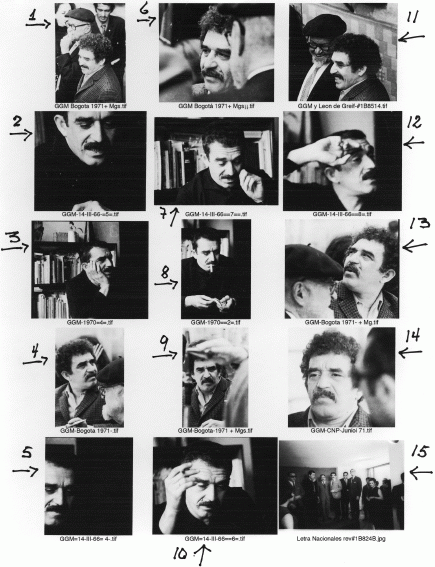
This biographical exploration has been a decade in the making. The idea was first suggested to me around 1998 by my friend Gayatri Patnaik, my editor at Routledge at the time. Since then I’ve traveled around the globe to meet extraordinary people and engaged them in dozens of interviews. In Colombia, with the helpful guidance of Eduardo Maireles, I journeyed, with paused dedication, across la ruta garciamarqueana, visiting Aracataca, Riohacha, Santa Marta, Sucre, La Ciénega, Barranquilla, and Cartagena. I learned just how much literature matters in a region of the world plagued by illiteracy. The effigy of Gabriel García Márquez, known to everyone as Gabito, is everywhere—literally and symbolically. He is seen as a redeemer, a man whose statue is held in equal honor to that of another messianic figure: Simón Bolívar, El Libertador.
First and foremost, I wish to thank García Márquez for the way he has refined his talent in his oeuvre, pushing it to its limits. As I relate in the preface, I was dumbstruck when I first read him as a twenty-one-year-old in my native Mexico. It suddenly became clear to me that words have magic: when used meticulously, they are able to conjure alternative universes, some more appealing than our own.
My wholehearted gracias to Cass Canfield Jr. of HarperCollins, friend and editor extraordinaire, who throughout the years encouraged me to pursue the writing of this biography. I spent marvelous hours with him talking about his passion for One Hundred Years of Solitude. Thanks to Airié Stuart of Palgrave for her patience and insistence. It is due to her, in large measure, that I’ve focused my whole attention on this endeavor. Jill Kneerim at Palmer & Dodge believed in the project. Steve Wasserman, at the Los Angeles Times Book Review, asked me to reflect, at different times, on a number of García Márquez’s books, as did Oscar Villalón at the San Francisco Chronicle and Jim Concannon at the Boston Globe. Thanks to Henry Louis Gates Jr. and Mike Vásquez for opening the doors of Transition, to Henry Finder at the New Yorker, Laurence Goldstein at the Michigan Quarterly Review, Fidel Cano Correa at El Espectador, Martin Levin at the Globe and Mail, Karen Winkler at the Chronicle of Higher Education, and Erica González at El Diario.
I appreciate the openness and la calidad humana of my dear Hugo Chaparro Valderrama in Bogotá and Juan Fernando Merino of El Diario in New York. The Colombian photographer Nereo López-Meza regaled me with a fiesta of images of García Márquez’s coastal landscapes and his journey to Stockholm. I am all the better as a result of the guidance I received in Barranquilla from Meira Delmar as well as from Heriberto Fiorillo, who hosted me at La Cueva; Iliana Restrepo, who was in charge of la ruta garciamarqueana in Cartagena; Rafael Darío, director of the Casa Museo García Márquez, who was generous with his time and knowledge as he took me around in Aracataca; the welcoming Jaime García Márquez at the Fundación Nuevo Periodismo in Cartagena; the wonderful Elkin Restrepo in Medellín; and the erudite Juan Gustavo Cobo Borda in Bogotá, where Claudia Leyva and Piedad Bonnett made me feel comfortably at home.
I’m honored with the friendship of Harold Augenbraum at the National Book Foundation, Jonathan Galassi at Farrar, Straus, and Giroux, and Max Rudin at the Library of America. I felt a kindred soul in Gregory Rabassa, with whom I discussed in detail issues of translation. I’ve enjoyed the numerous conversations I’ve entertained with scores of people in and beyond García Márquez’s circle. I’ve had dialogues with Isabel Allende, Fernando del Paso, Augusto Monterroso, Antonio Muñoz Molina, Álvaro Mutis, Elena Poniatoska, and John Updike. I appreciate the support of Gloria Gutiérrez at the Carmen Balcells Literary Agency in Barcelona; Donald Yaes in California; Alberto Blanco, Angelina Muñiz-Huberman, and Alejandro Springall in Mexico City; Ali White in Vermont; Edith Grossman and Silvana Paternostro in New York; Jesús Díaz and Martín Felipe Yriart in Madrid, Spain; Alicia Agnese-Milia and Héctor Urrutibéheity in Houston, Texas; Isaac Goldemberg and Daisy Cocco de Fillippi at Hostos Community College; Alberto Fuguet and Iván Jaksic in Santiago, Chile; Alberto Manguel in Paris; Antonio Benítez-Rojo at Amherst College; Francisco Goldman at Trinity College; Caryl Phillips at Yale University; Edmundo Paz-Soldán at Cornell University; John King at University of Warwick; and Tomás Eloy Martínez at Rutgers University.
Verónica Albin read the manuscript in different versions, offering insightful suggestions. With insistence as well as undiminished cordiality, Marie Ostby, Leah Carroll, and Yasmin Mathew shepherded it through production.
I have benefited enormously from, and made use of, the foundational work done by journalists and scholars who came before me and whose contribution I used as a compass, particularly Jon Lee Anderson, Gene H. Bell-Villada, Eligio García Márquez, Jorge García Usta, Rita Guibert, Jacques Gilard, Luis Harss, Gerald Martin, George R. McMurray, Dasso Saldívar, Mario Vargas Llosa, Ernesto Volkening, and Michael Wood. I tested my ideas with my students at Amherst College in the courses on One Hundred Years of Solitude I taught, intermittently, from 2001 to 2009. Their intelligence and dedication always inspires me.
My beloved parents Abraham and Ofelia Stavchansky in Mexico City allowed me to use their house as my headquarters. My mother even functioned as a liaison with the García Márquez entourage. Mi corazón está lleno.
All photographs by Nereo López-Meza. © Copyright 1970, 2009 by Nereo. Used by permission.